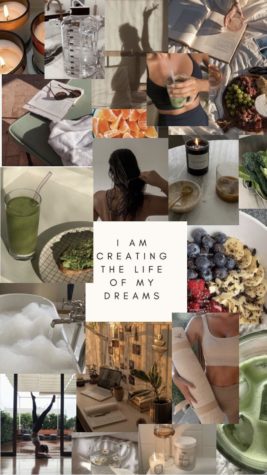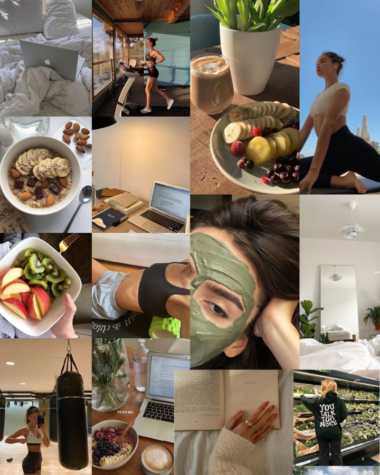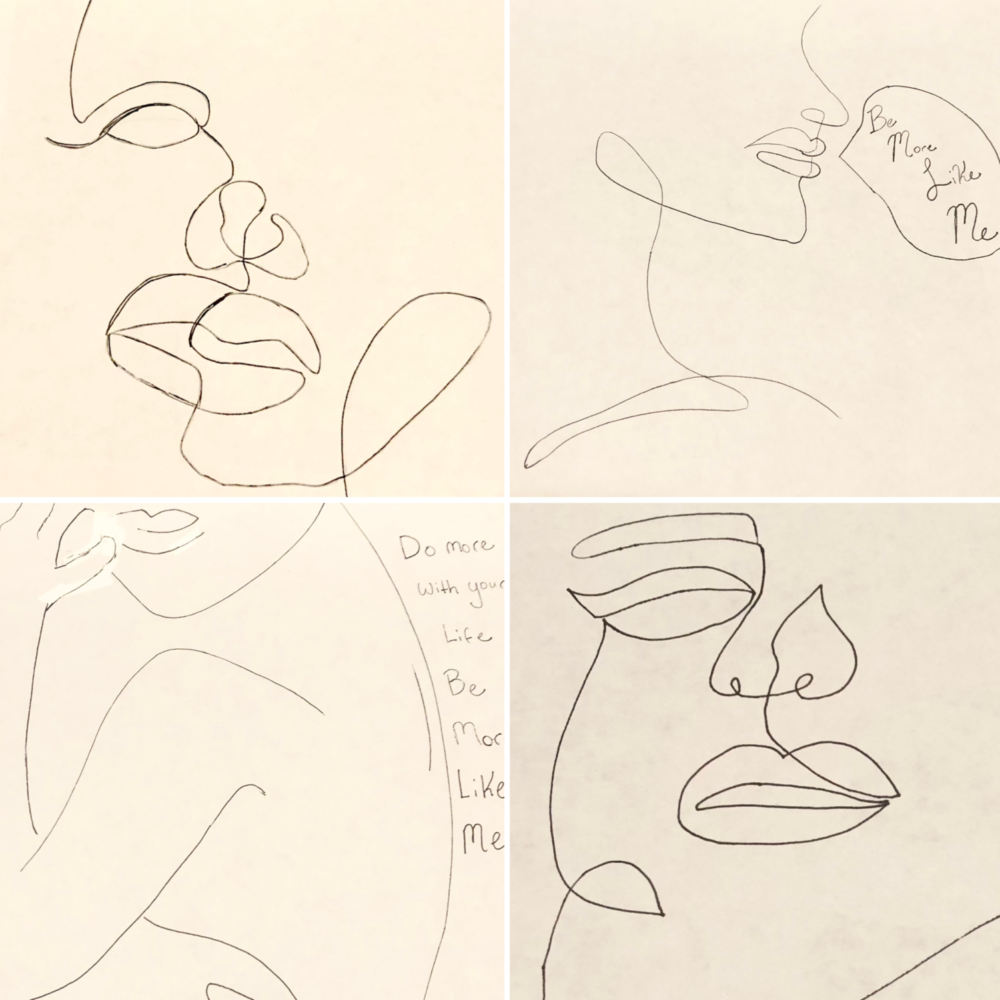The Toxicity of “That Girl” and how she F&%&@d everyone up.
The lingering side effects of the "That Girl" trend.
March 30, 2023
Keep in mind: I’m not trying to villainize social media. I like social media. I do believe that there are fun and harmless trends that bring people comfort and joy on social media, but it’s important to recognize the negative aspects of different trends or ideas that are taken too seriously and become all-consuming and inadvertently harmful.
During the lockdown, social media was all-consuming. Social media was the only outlet connecting everybody’s daily lives. When everything was remote, social media was a lifeline, it became the place to see social norms.

It might seem silly to say that TikTok played a fundamental role in the worldwide COVID-19 pandemic, but it’s incredibly important to understand that trends during the lockdown became a norm that many felt pressured to adhere to, due to peoples isolation from normal outside influencers, like other people. It’s important for teenagers to have a tribe, people who are like-minded. Throughout in-person school, kids often split into friend groups engaging with people of similar mindsets, interests, and values.
During the pandemic, teens were completely isolated from each other. They didn’t have a tribe but did have access to worldwide platforms with thousands of influencers to mimic. This is arguably equivalent to the “head of groups” in high school, the shot caller, the trendsetter, and the ringleader.
The act of mimicking people we find cool isn’t new, rather it’s comparable to the basic survival qualities of human beings. We learn through observation, copying the quirks and qualities of others we find admirable and secure. “You’re cool so I’m going to copy you, so you think I’m cool too; this way you’ll accept me and I’ll be part of this tribe.” Now, this stems from even a more primitive line of thinking; “I see that you’re surviving so I am going to copy you in hopes I survive too.” The modern spin on this can be easily viewed during lunchtime in any high school. All the “wannabe popular” members desperately try to copy the ringleaders’ mannerisms, style, lifestyle, etc, in hopes that this will raise their own popularity because obviously, popularity in high school equals survival (cue eye roll).
Basically, humans have learned over time that mimicry is the glue to social groups, it creates cohesion due to the similarity between each member. It’s easier to like a carbon copy of yourself than a polar opposite. Opposites attract is really a modern concept.
Unfortunately, this adaptive tact hasn’t modernized and still holds the same level of pressure it did when it was used for survival. This pairs dangerously with some of the social media’s toxic trends, the one in focus being the “that girl” trend.
The “that girl” trend started off as a promotion of health and wellness in people’s daily lives during the second lockdown era of COVID. This was okay, obviously, we all could have done with a reminder to add movement to our daily lives during the monotonous days of COVID-19 lockdown procedures. I think the problem started when the trend morphed into “day in the life/daily routine” videos. During COVID, everyone’s lives fell way off track many already felt varying levels of depression due to the isolation. The last thing we needed was to be bombarded with videos showing people maximizing every moment of their day and taking productivity to a whole new level. It set an unsustainable goal during one of the hardest periods of most people’s lives.
Unfortunately, during COVID, when everybody looked to social media for inspiration, this was a really unfortunate “norm” to see. Of course, many people did participate in the trend, unaware of the negative effects.
“Definitely during COVID times, there was a lot of laying around like, honestly eating a lot of food, all we did was just sit around and eat a lot of food and watch TikTok. When videos of girls, especially pretty girls were coming up on your for you page being overly productive and everything was planned, it sucked,” Sophia Robertson (‘25) said. “Their meals were planned, everything was healthy and they looked super happy. It made me feel very down on myself watching those types of videos. I even attempted to do it, and honestly, it did cause a really bad relationship with food.”
Unfortunately, this mindset was not uncommon during lockdowns due to isolation and an extreme amount of social media exposure, specifically, trends that focus on meticulous routines portrayed by extremely fit individuals.
A falsely advertised part of this trend was the fact that it was not a “body conscious” trend, instead of chasing just physical results, like most health and wellness trends. Instead, it was a trend based on healthy routines and maintaining a healthy lifestyle.

Unfortunately, the majority of viral videos featured tall, skinny girls, eating minimal amounts of food and working out extensively. Now, I’m not saying this was the original intent of the trend, but that is what it morphed into, simply because unconsciously there has always been an expectation unconscious or not for girls’ body types to look a certain way in the case of the “that girl trend” being thinner, “put together” or prettier.
To promote yourself as a “healthy girl” or “that girl” on social media, it seems that being fit and thin is a big component of posting content on that trend and having your videos do well, due to the still remaining bias against bigger girls.
I’m simply pointing out that bigger girls did not tend to go viral, both within this trend and in general, due to people’s heavy praise for thinner girls, videos with thinner girls soon took over the majority of people’s For You Page due to TikTok’s algorithm. Also, when there were viral videos of bigger girls participating in the trend they did not go viral for the same reasons and didn’t receive the same reactions as videos with smaller girls.
“I know if they were bigger girls the comments would be focusing on their journey,” Robertson noticed. “People were trying to be nice and be like, ‘you slay girl,’ ‘You’re SOOOO pretty,’ ‘I love your self-love’. But if it was a skinny girl that posted a video the comments would say, ‘Wow, I want to be her. She is “that girl”.’”
The standards this trend has piled on women and girls are out of this world. We have to look good, and maintain an almost militant daily routine, by eating healthy at every meal and constantly working out. Not only is it not a sustainable lifestyle for anyone, but for a lot of working individuals, there’s just not enough time in the day to fit it in.
“I feel like the standards at this point are just that they’re stupid,” Lily Klapper (‘25) said. “They’re [the trends] getting to a level where it’s just stupid. If you’re not perfect, it’s just not possible to do.”
Social media’s purpose is to inspire, not discourage people from living their best life. This demand for perfectionism is heavily deterring people from trying [to progress and instead is just making people feel discouraged when their attempts fail.
“The “that girl” trend definitely made me feel worse. I feel like it kind of initiated the whole “gym trend” and to have whole week workout plans (split workout). Actually, in the summer, I made this whole list for myself; I’d wake up at like five in the morning and go on a run, and then I would make a smoothie or whatever. it was stupid and it lasted for half a day,” Klapper said.
Unsustainable, these trends are absolutely unsustainable. I would like to believe that under normal circumstances, we would have been able to reasonably see how this trend was created by influencers whose job is to make aesthetic videos, not everyday people.
“I posted a video recently of some of my habits I do in the morning, I made them look more aesthetic with better lighting and better backgrounds,” Ella Caggiano, a bodybuilder and fitness influencer said. “With all of the different shots that I took, it actually took me a couple of hours to completely like make the entire video with all the different angles and trying to get the right lighting.”
These videos are purposefully made only for aesthetics that people will find appealing and enjoy watching, instead of truthfully showing the mundane reality of their morning routines. That was social media’s original purpose; to entertain and inspire, just with COVID’s slightly altered use of social media, it took an unhealthy turn.

The “that girl” trend consisted of four main components: eat well, workout every day, good skincare, and dress well. I think prioritizing mental health was in there too, but the message was if you completed these steps your mental health would improve. It was exhausting, I don’t think anyone’s mental health improved.
“After a while of trying to do everything, obviously you can’t do it anymore. I’d fall back on bad habits or something like, instead of doing something else, I would just like to give up on everything,” Amelie Moustratts (‘25) said. “I’d just go on my phone for hours. Before the trend, I would maybe like to read a book or something. But now, I feel like I can’t do anything because if I can’t do that [said steps in the “that girl” trend], then I can’t do anything.”
I think the guilt was the unspoken toxic effect of the trend. No one wanted to admit that they “lacked the discipline” and were unable to complete the trend. Due to what we saw on social media, we thought everyone was completing the trend successfully.
I think a big aspect of this trend is how it was secret. You wouldn’t tell anybody you were trying it, I mean why would you? The “that girl” trend created an almost unspoken competitive environment, “that girl” refers to a singular girl, one spot. Everyone vied for that spot. The question was who could do the most effortlessly. Again, this competitive attitude is rooted in a misperception of influencers’ lives, unaware that the majority only make aesthetic videos and don’t actually follow the routines and lifestyles they post about.
“I know any person that I’ve met from the fitness industry and just people that I know in general, no one’s life actually looks like that “that girl” trend, and in fact, I think it is very deterrent to other people who are looking to start a healthy lifestyle,” Caggiano said.
That’s one hundred percent true, breaking out of old habits and trying to form new ones is already a really intimidating change. It’s important that social media caters to that by not having advanced routines that intimidate and inspire guilt when uncompleted. The key is creating trends that encourage people and give them the motivation and tools which can help them become their best, authentic selves.
